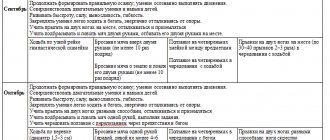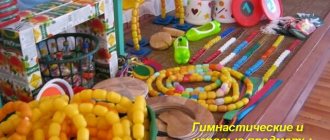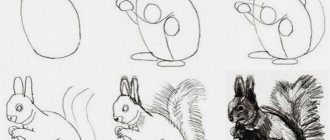Text of the book “Physical education in kindergarten. System of work in the senior group"
Lyudmila Ivanovna Penzulaeva
Physical education in kindergarten. System of work in the senior group
Dear Colleagues!
This manual was published as part of an educational and methodological set for the approximate basic general education program of preschool education “FROM BIRTH TO SCHOOL”. The program “FROM BIRTH TO SCHOOL” is a revised version in accordance with Federal State Requirements (FGT, Order N? 655 of November 23, 2009) of the “Program of Education and Training in Kindergarten”, ed. M. A. Vasilyeva, V. V. Gerbova, T. S. Komarova.
Until the release of the complete educational and methodological set for the program “FROM BIRTH TO SCHOOL”, teachers can use in their work the manuals published for the “Program of Education and Training in Kindergarten”, ed. M. A. Vasilyeva, V. V. Gerbova, T. S. Komarova.
Penzulaeva Lyudmila Ivanovna –
candidate of pedagogical sciences, author of scientific articles and teaching aids on the physical education of children.
Introduction
This manual presents a system of working with children 5–6 years old in physical education.
According to the current SanPiN 2.4.1.2660-10, direct educational activities on the physical development of children 5–6 years old are organized at least 3 times a week. Its duration is 30 minutes.
Once a week for children 5–7 years old, direct educational activities on physical development in the open air should be organized all year round. It is carried out only if children have no medical contraindications and they have sportswear appropriate for weather conditions.
In the warm season, under favorable meteorological conditions, educational activities on physical development are organized in the open air.
Further in the manual, for convenience of presentation, instead of the term “direct educational activity,” we will often use the term “occupation,” which is familiar to teachers. However, the term “class” should not mislead teachers: it does not imply lesson-type classes. The teacher’s task is not to turn a physical education lesson into a lesson, but to use forms of work with children appropriate to their age, indicated in the approximate basic general education program for preschool education “From birth to school,” ed. N. E. Veraksy, T. S. Komarova, M. A. Vasilyeva.
According to the principle of integration, the physical development of children is carried out not only in the process of specific physical education and sports games, exercises and activities, but also in the organization of all types of children's activities through physical education, didactic games with elements of movement, outdoor games with elements of speech development, mathematics, design and etc.
The teacher should purposefully organize the educational process so that children are required to have optimal motor activity in all types of children's activities (not just answering a question, but answering and clapping, answering and passing the ball, etc.). This approach not only stimulates physical development, but also contributes to a more successful solution of other educational tasks.
In the process of educational activities on physical development, attention should be paid to the simultaneous solution of problems in other educational areas:
– developing safe behavior skills in outdoor and sports games, when using sports equipment (“Safety”);
– creation in the process of educational activities on physical development of pedagogical situations and situations of moral choice, development of moral qualities, encouraging manifestations of courage, resourcefulness, mutual assistance, endurance, etc., encouraging children to self-esteem and evaluation of the actions and behavior of peers (“Socialization”);
– involving children in arranging and cleaning physical education equipment and equipment (“Labor”);
– activation of children’s thinking (through independent choice of games, equipment, counting balls, etc.), organization of special exercises for orientation in space, outdoor games and exercises that consolidate knowledge about the environment (imitation of animal movements, adult labor);
– encouraging children to pronounce actions and name exercises, encouraging speech activity in the process of motor activity, discussing the benefits of hardening and physical education (“Communication”);
– organization of games and exercises based on the texts of poems, nursery rhymes, counting rhymes; plot-based physical education classes on the themes of read fairy tales and nursery rhymes (“Reading Fiction”);
– attracting the attention of preschoolers to the aesthetic side of the appearance of children and the teacher, the design of the room; using elementary physical education aids made by children (flags, pictures, throwing targets) in physical education classes, drawing chalk markings for outdoor games (“Artistic Creativity”);
– organization of rhythmic gymnastics, games and exercises accompanied by music, singing; holding sports games and competitions with musical accompaniment; development of artistic abilities in outdoor games of an imitation nature (“Music”),
Physical education of preschoolers is a unified system of educational and health activities in the daily routine, including daily morning exercises, educational activities on physical development, outdoor games and entertainment indoors and outdoors under the direct supervision of the teacher.
Sample notes are built according to a generally accepted structure and include training in basic types of movements, sets of general developmental exercises with various subjects and outdoor games. All physical education classes are conducted in a playful and entertaining manner. At the end of each month, material is presented for repetition and consolidation of what has been learned, which the teacher can change or supplement at his own discretion.
An important place in working with children aged 5–6 years is occupied by outdoor games, play exercises and tasks. In games, children not only develop and strengthen their physical qualities, but also develop responsibility for themselves and other children (mutual assistance, support, moral principles of behavior in a team). The main thing is that activities and games indoors and on the kindergarten playground bring children pleasure and joy, increase confidence in their abilities, and develop independence.
Features of development of children 5–6 years old
The age period from 5 to 7 years is called the period of “first extension”; in one year a child can grow up to 7-10 cm. The average height of a 5-year-old preschooler is about 106-107 cm, and body weight is 17-18 kg. During the sixth year of life, the average increase in body weight per month is 200 g, and height is 0.5 cm.
The development of the musculoskeletal system (skeleton, joint-ligamentous apparatus, muscles) of a child by the age of five or six is not yet complete. Each of the 206 bones continues to change in size, shape, structure, and the development phases of different bones are not the same.
The fusion of parts of the ethmoid bone of the skull and ossification of the auditory canal are completed by the age of six. The fusion of parts of the occipital, main and both halves of the frontal bones of the skull is not yet complete by this age. Cartilaginous zones are preserved between the bones of the skull, so brain growth continues.
Ossification of the supporting bones of the nasal septum begins at 3–4 years of age, but is not yet complete by the age of six. These features must be taken into account when conducting all physical education classes in order to avoid injuries, since even mild bruises in the nose, ear or head can have serious health consequences.
The greatest likelihood of injury occurs when performing exercises associated with reducing the area of support or increasing it - walking on a gymnastic bench, slats, beams, when children easily lose their balance; in exercises with the ball - the child has enough strength to throw the ball to a partner, but insufficiently developed coordination of movements can distort the direction of flight, and then the ball hits not the hands, but the face, so children need to be given timely instructions, reminded that the ball is needed throw into the hands of a partner. Systematic exercises for children with a ball are organized during a walk in the form of game exercises: “Hit the hoop”, “Knock down the pin”, “Toss - catch”, etc. The use of tennis balls in activities with children of this age is undesirable.
The spinal column of a 5–7 year old child is sensitive to deforming influences. Skeletal muscles are characterized by poor development of tendons, fascia, and ligaments. With excess body weight, as well as under unfavorable conditions (for example, with frequent lifting of weights), the child’s posture is disturbed: a swollen or saggy belly may appear, flat feet, and in boys a hernia may form. Therefore, while children are performing work assignments, the teacher must monitor the feasibility of physical activity. For example, in order to take benefits and small equipment to the site, move benefits to the hall, or move something, it is necessary to involve several children at the same time.
The elasticity and flexibility of a child's bone can cause injuries not only to the limbs, but also to the spine (when falling from a swing, slide, etc.). It should also be taken into account that if a child falls from a slide, collides with a sled, or is hit by skis, damage to the abdominal cavity (liver, kidneys, spleen) can easily occur.
Some joints also develop disproportionately in preschoolers. For example, in the period up to 5 years, the bursa of the elbow joint grows quickly, and the annular ligament, which holds the head of the radial bone in the correct position, turns out to be too loose. As a result, subluxation often occurs (if you pull the baby's hand). The teacher must warn parents about this.
In children 5–7 years old, the structure of the foot is incomplete. In this regard, it is necessary to prevent the development of flat feet in children, which can be caused by shoes that are larger than necessary, excess body weight, or previous diseases. Educators and parents should listen to children’s complaints about fatigue and pain in the legs in a static position and when walking and running.
There are several stages in muscle development, including the age of 6 years. By the age of six, the child has well-developed large muscles of the trunk and limbs, but small muscles, especially the hands, are still weak. Therefore, children learn walking, running, and jumping exercises relatively easily, but certain difficulties arise when performing exercises related to the work of small muscles.
The basis for the manifestation of motor activity is the development of stable balance. It depends on the degree of interaction of proprioceptive, vestibular and other reflexes, as well as on body weight and support area. With age, the child’s indicators of maintaining stable balance improve. When performing balance exercises, girls have a slight advantage over boys. In general, in the older group, children still find it easier to do exercises where there is a large area of support, but short-term exercises that require support on one leg are also possible, for example, in outdoor games: “Make a figure,” “Owl,” “Don’t stay on the floor.” " and etc.
Thanks to experience and targeted physical education (classes, play exercises, outdoor games), children of this age perform exercises in basic types of movements more correctly and consciously. They are already able to differentiate their muscle efforts, which means that they are able to perform exercises with different amplitudes and move from slow to faster movements according to the teacher’s instructions.
When conducting general developmental exercises, the teacher takes into account that children of this age are familiar with the directions of movements: up, down, right, left, etc.
Children develop an analytical perception of the movements they are learning, which significantly, compared to the previous age group, accelerates the formation of motor skills and improves them qualitatively.
The development of the central nervous system is characterized by the accelerated formation of morphophysiological characteristics. Thus, the brain surface of a six-year-old child is already more than 90 percent the size of the cerebral cortex of an adult. The frontal lobes of the brain are rapidly developing; children are aware of the sequence of events and understand complex generalizations.
At this age, the basic processes are improved: excitation and especially inhibition, and all types of conditioned inhibition are formed somewhat more easily. Tasks based on inhibition should be dosed wisely, since the development of inhibitory reactions is accompanied by changes in heart rate and breathing, which indicates a significant load on the nervous system.
In children 5–6 years old, dynamic stereotypes, which form the biological basis of skills and habits, are formed quite quickly, but their restructuring is difficult, which indicates insufficient mobility of nervous processes. For example, a child reacts negatively to a change in his usual way of life. In order to improve the mobility of nervous processes and give flexibility to the skills being formed, they use the technique of creating a non-standard (partially temporarily changed) environment when conducting routine processes, outdoor games, etc.
Development of the cardiovascular and respiratory systems. By the age of five, the size of a child’s heart (compared to the neonatal period) increases 4 times. Cardiac activity is also intensively formed, but this process is not completed throughout preschool age.
In the first years of life, a child's pulse is unstable and not always rhythmic. Its average frequency by 6–7 years is 92–95 beats per minute. By the age of 7–8 years, the development of the nervous apparatus that regulates cardiac activity is largely completed, and the work of the heart becomes more rhythmic.
The size and structure of the respiratory tract of a preschooler differs from those of an adult. They are much narrower, so violation of the temperature and humidity in the room leads to respiratory diseases. Proper organization of children's motor activity is also important. With its deficiency, the number of respiratory diseases increases by about 20 percent.
The vital capacity of the lungs in children 5–6 years old is on average 1100–1200 cm3, but it also depends on many factors: body length, type of breathing, etc. The average number of breaths per minute is 25. Maximum ventilation of the lungs by the age of six is approximately 42 dc3 of air per minute. When performing gymnastic exercises, it increases 2–7 times, and when running – even more.
Studies to determine the general endurance of children (using the example of running and jumping exercises) have shown that the reserve capabilities of the cardiovascular and respiratory systems in preschool children are quite high.
The need for physical activity in many children is so great that doctors and physiologists call the period from 5 to 7 years the “age of motor extravagance.” The teacher’s tasks are to monitor the motor activity of children, taking into account their individuality, preventing cases of hyperdynamia and activating children who prefer “sedentary” games.
Methodological recommendations for working with children 5–6 years old
In the senior group of kindergarten, 3 physical education classes are held per week, lasting up to 30 minutes in the morning. Every third lesson is held at the kindergarten site.
The structure of physical education classes is generally accepted: introductory (4–6 minutes), main (18–20 minutes) and final (3–4 minutes) parts. Walking and running exercises are carried out in alternation. In the second part of the lesson, children are taught general developmental exercises and basic types of movements; An outdoor game is required. In the final part, walking exercises, simple game tasks, and low-mobility games are used.
General developmental exercises have a targeted effect on the body as a whole, on individual muscle groups and joints, help improve coordination of movements, spatial orientation, and have a positive effect on the cardiovascular and respiratory functions of the body. The starting position is important for the correct implementation of general developmental exercises. Use different starting positions: standing, sitting, kneeling, lying on your back and stomach. By changing the starting position, you can make the motor load more difficult or easier.
When teaching exercises of a general developmental nature in the senior group, the teacher uses small (flags, cubes, skittles, sticks, etc.) and large (slats, large-diameter hoops, ropes, cords) physical education equipment.
Depending on what equipment will be used in the lesson, the teacher thinks through and plans the construction; in exercises with sticks and flags, it is advisable to form in columns and at a sufficient distance from each other, since another formation will not allow achieving the required range of movements and can lead to injuries.
In the older group, when performing general developmental exercises, children are given more complex tasks than before: clearly take different starting positions, perform exercises with different amplitudes (large, small), observe the direction of movement, etc. Before the start of the lesson, the teacher prepares large and small physical education equipment and places it in a certain place. As instructed by the teacher, children independently take flags, sticks, cubes, etc., and at the end of the exercises put them back in place. It must be taken into account that excessive load is harmful for a preschooler and can lead to undesirable consequences: the formation of umbilical and inguinal hernias, and poor posture.
Learning the basic types of movements is crucial. Exercises are selected in accordance with the requirements of the “From Birth to School” program.
In order to ensure the harmonious physical development of children, approximately the same number of exercises for each type of movement is provided throughout the year.
Each lesson offers three main types of movements. They are repeated in a certain sequence, becoming more complex and varying at relatively short intervals. In this case, not only the compatibility of movements is important, but also the learning tasks for each type at different stages: when learning exercises, when repeating and consolidating.
In the first week of each month, children should learn balance exercises, repeat jumping exercises, and consolidate throwing exercises; in the second week, jumping exercises are used for training, and skills in throwing and climbing are repeated and consolidated; in the third - they learn throwing exercises, repeat and consolidate them in climbing and balance; in the fourth - they teach climbing, practice balance and jumping.
Since outdoor play in each subsequent lesson includes elements of the basic type of movement that children mastered in the previous week as a learning activity, almost all types of basic movements are developed continuously.
The final part provides the child with a gradual transition from an excited state to a relatively calm one, and makes it possible to switch to another activity.
In accordance with the requirements of the approximate basic general education program of preschool education “From Birth to School,” in the senior group, one physical education lesson per week is required in the open air; Therefore, we should dwell in more detail on the methodology and organization of the third physical education lesson.
The structure of every third lesson is generally accepted and follows the same pattern (introductory, main and final parts).
However, there are some specific features in conducting physical education while walking.
The first part should put the children’s body in a state of preparedness for the main part, the second part offers simple tasks in walking, running, combinations with various tasks that are performed at the teacher’s signal.
The second part includes play exercises using jumping, running, throwing, climbing, etc. The organization, in which children are divided into a larger number of groups (teams), allows increasing physical activity, providing variety and increasing interest in the exercises performed. In addition, in these exercises there is an element of competition between children and groups at the same time.
The third, final part of the outdoor lesson is small in volume; It involves low-intensity games and play exercises that promote a gradual decrease in motor activity approaching the initial level.
Thus, in classes held in the fresh air, training in basic types of movements is built through game exercises in running, jumping, throwing, using games with elements of sports and outdoor games.
In the spring-summer period, when clothing does not restrict the children’s movement, the teacher, at his discretion, can include general developmental exercises in the lesson without objects and with various equipment. This applies more to regions with mild climates. And, conversely, in long winter conditions it is quite possible to increase the number of activities using exercises on sleds, skis, etc.
When conducting classes outdoors, the main thing is to properly and clearly organize the children. In this case, various options are possible, for example:
– children simultaneously perform (frontal method) game exercises in a line (throwing balls, rolling hoops), then divide into pairs (in ball games, games with sports elements (badminton, basketball, football, hockey));
– children are divided into subgroups, with one subgroup practicing under the guidance of a teacher, and the other independently performing two or three exercises in a row, then the children change places;
– children are divided into 3-4 groups, each group is offered a task, and according to a conditioned signal, places and tasks are changed.
When conducting outdoor games and relay races, it is important to observe measures to prevent injuries: maintain a distance between children while running and jumping; transfer benefits, involving a sufficient number of guys in this, etc.
The duration of the walk depends on the climatic and weather conditions. You can conduct a physical exercise session in the fresh air immediately before the walk, then change the children’s clothes and continue the walk, or conduct a lesson at the end of the walk.





